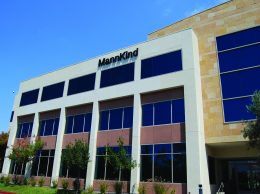Amgen alum speeds toward OK for chin drug
IN THIS ARTICLE
- East Ventura County Topic
- Erika Martin Author
By Erika Martin Friday, April 10th, 2015
After a nine-year development phase, Kythera Biopharmaceutical is on the verge of bringing to market its first drug, a facial injection for the treatment of double chins.
Known as ATX-101, the drug was unanimously recommended for approval on March 9 by a U.S. Food & Drug Administration advisory committee. Now, the FDA has until May 13 to make its final decision on the drug, which would be the market’s first non-surgical produced to reduce submental fat.
Kythera, a publicly traded Westlake Village firm, was founded in 2005 and is headed by Keith Leonard, the former head of Amgen’s European operations. It has flown under the radar for several years while it navigated the lengthy development and approval process, but was still able to raise a $70 million IPO in 2012 and $90 million in capital in 2014. Last year it moved from its Calabasas headquarters to a new, larger space in Westlake Village.
“We’re a little over nine-and-a-half years old as a company and this is a product we’ve been working on from the very beginning,” Leonard said. “This is a long time in the making. But that is one of the things that makes this industry special, makes it difficult, makes it attract a certain kind of people.”
ATX-101 is patented synthesis of a pure, non-animal-derived version of deoxycholic acid that enables the breakdown of dietary fat. Perhaps the most promising aspect of the drug its potential to appeal to a large number, and large variety, of patients. Leonard said many people with double chins are neither old nor overweight but simply genetically predispositioned to carry extra weight in the face.
“It all goes back to market size. So many people ultimately declare being bothered by fullness under their chin, and they haven’t had a tool to address it before,” Leonard said. “If we’re approved, we’ll be that tool for something that bothers them but had not been treated.”
Although the product still awaits approval, Leonard said its success is likely and “if something does crop up, it will be a surprise.”
Existing injection products like Botox and fillers have been mainly geared toward women, and Leonard said females now accounts for about 90 percent of sales in the injectables market. Kythera’s treatment, he said, has the potential to get more men interested in cosmetic pharmaceuticals.
“We know by our market research, both formal and informal, that men are bothered by submental fullness,” Leonard said. “Men are generally not as concerned about facial wrinkles, but we know from our clinical studies that treating the submental fullness and improving the appearance under the chin yields really positive results for men and women.”
The product’s patient satisfaction ratings have been especially promising, Leonard said.
“The technical data is important for substantiating the product performance, but the real adoption will come through because patients want to change the way they feel about themselves through the way they look,” he said. “I think that story will be written over several years here as well roll the product out.”
Kythera hopes to launch ATX-101 in the second half of this year. On March 16, the company closed a $134.5 million underwritten public offering to secure the capital needed to take the drug to market.
Leonard left Amgen in 2004. He said it was a tough choice, but he had always wanted to start a company from scratch, “turning an idea into reality.” He was driven by the notion of bringing the tools, science, rigor and innovation of biotechnology to aesthetic medicine.
“We were attracted to aesthetic medicine because patients seek treatment — they desire improvement,” Leonard said. “Physicians are happy to deliver that, so it’s kind of happy medicine. We know that patients can get nice results and we know it changes the way they feel about themselves.”
Kythera has benefited from a series of layoffs at Amgen’s Thousand Oaks headquarters over the last few years, as well as the closing of Botox maker Allergan’s Goleta facility.
“We have hired many former Amgen employees into our midst here and many of what I call our core functions, like manufacturing and quality and legal, are drawn largely from Amgen’s people that have just superb backgrounds,” Leonard said. “And Allergan really created this whole product category from scratch, so we’ve been able to attract incredible talent from them. You can have great ideas and good funding, but you have to have the right people in place to make it all real, and we’ve been really lucky at attracting extremely good talent.”
Other successful Amgen spinoffs include Atara Biotherapeutics, which went public on the strength of its licenses to develop Amgen drug assets and relocated from Thousand Oaks to San Francisco. Thousand Oaks-based ImmunGene, a cancer treatment firm led by former Amgen scientist Sanjay Khare, is working on antibody-cytokine fusion technology that could help improve doctors’ ability to target cancer cells.
Although it took a decade to get where it is, Kythera isn’t pausing to catch its breath. The company spent $84 million last year to purchase the end license of a drug from ex-partner Bayer AG. Named KYTH-105, the molecule aligns with a shared research project on male pattern baldness between Kythera and the University of Pennsylvania’s head of dermatology, Dr. George Cotsarelis.
While ATX-101 has an enormous pool of potential patients, that figure would look weak next to the number of men with hair loss issues. “We think we have a very novel approach to male-pattern baldness, and we will be taking that product in the clinic in the near future to test out this hypothesis for prevention of male pattern baldness,” Leonard said.
As the Business Times went to press Wednesday afternoon, Kythera shares were trading at $47 a share, compared to $34.04 a year ago. The company has a market capitalization of $1.08 billion.











